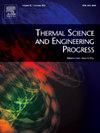Effect of oxygen and particle size on the oxidation-pyrolysis competition during coal char reburning: A thermogravimetric kinetic study
IF 5.1
3区 工程技术
Q2 ENERGY & FUELS
引用次数: 0
Abstract
The parallel competitive mechanism involving oxidation-pyrolysis kinetics dominates in governing the combustion dynamics and propagation of coalfield fires through fluctuating oxygen concentration. This study proposed a four-lump reaction kinetic model for oxygen-lean coal char combustion involving 17 parameters to be optimized. The contributions of each sub-reaction to the kinetic rates and mass evolution during coal char oxygen-lean combustion was delineated and quantified based on resolving the thermogravimetric data. The influence of oxygen concentration and particle size on the kinetic reactivity within the oxidation-pyrolysis competitive mechanism was elucidated. The results indicated that the immediate oxidation of initial coal char active structure (Rβ) consistently predominated across the entire oxygen-lean gradient, successively followed by coke oxidation (Ro), incompletely pyrolysis of initial coal char active structure (Rα) and condensation gasification reaction of semi-coke (Rp). As the oxygen concentration increased from 1 % to 13 %, the competitive coefficient χ decreased from 0.608 to 0.077, and the proportion of mass loss contributed by sub-reaction Rβ rose from 42.32 % to 93.37 %. The ignition mechanism shifted from heterogeneous ignition to homogeneous ignition at a transitional oxygen concentration of 9 % oxygen, while the critical value for coal char to transition from slow smoldering to rapid combustion was determined as 3 %. The particle size gradient influenced the combustion reactivity of coal char with 306 μm serving as a critical threshold. This study offers critical insights into the kinetic mechanisms and advanced monitoring strategies essential for mitigating coalfield fire hazards, contributing to the development of more effective control and prevention methodologies.
氧和粒度对煤焦再燃过程中氧化热解竞争的影响:热重动力学研究
含氧化热解动力学的平行竞争机制在控制煤田燃烧动力学和通过波动氧浓度传播的过程中起主导作用。本研究提出了含氧贫煤焦燃烧的四团反应动力学模型,涉及17个参数进行优化。在分析热重数据的基础上,对煤贫氧燃烧过程中各子反应对动力学速率和质量演化的贡献进行了描述和量化。在氧化热解竞争机制中,阐明了氧浓度和粒径对反应动力学的影响。结果表明:在整个贫氧梯度上,初始煤焦活性结构(Rβ)的直接氧化反应始终占主导地位,其次是焦炭氧化反应(Ro)、初始煤焦活性结构(Rα)的不完全热解反应和半焦的缩合气化反应(Rp)。当氧浓度从1%增加到13%时,竞争系数χ从0.608下降到0.077,亚反应Rβ贡献的质量损失比例从42.32%上升到93.37%。在氧气浓度为9%的过渡条件下,煤焦的燃烧机理由非均匀燃烧向均匀燃烧转变,由缓慢阴燃向快速燃烧过渡的临界值为3%。粒径梯度对煤焦燃烧反应性的影响以306 μm为临界值。这项研究为减少煤田火灾危险的动力学机制和先进的监测策略提供了重要的见解,有助于开发更有效的控制和预防方法。
本文章由计算机程序翻译,如有差异,请以英文原文为准。
求助全文
约1分钟内获得全文
求助全文
来源期刊

Thermal Science and Engineering Progress
Chemical Engineering-Fluid Flow and Transfer Processes
CiteScore
7.20
自引率
10.40%
发文量
327
审稿时长
41 days
期刊介绍:
Thermal Science and Engineering Progress (TSEP) publishes original, high-quality research articles that span activities ranging from fundamental scientific research and discussion of the more controversial thermodynamic theories, to developments in thermal engineering that are in many instances examples of the way scientists and engineers are addressing the challenges facing a growing population – smart cities and global warming – maximising thermodynamic efficiencies and minimising all heat losses. It is intended that these will be of current relevance and interest to industry, academia and other practitioners. It is evident that many specialised journals in thermal and, to some extent, in fluid disciplines tend to focus on topics that can be classified as fundamental in nature, or are ‘applied’ and near-market. Thermal Science and Engineering Progress will bridge the gap between these two areas, allowing authors to make an easy choice, should they or a journal editor feel that their papers are ‘out of scope’ when considering other journals. The range of topics covered by Thermal Science and Engineering Progress addresses the rapid rate of development being made in thermal transfer processes as they affect traditional fields, and important growth in the topical research areas of aerospace, thermal biological and medical systems, electronics and nano-technologies, renewable energy systems, food production (including agriculture), and the need to minimise man-made thermal impacts on climate change. Review articles on appropriate topics for TSEP are encouraged, although until TSEP is fully established, these will be limited in number. Before submitting such articles, please contact one of the Editors, or a member of the Editorial Advisory Board with an outline of your proposal and your expertise in the area of your review.
 求助内容:
求助内容: 应助结果提醒方式:
应助结果提醒方式:


